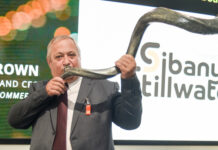
ILLEGAL mining is a huge and growing problem across much of Africa but it seems to be particularly prevalent in South Africa, where it is getting rapidly larger and more organised in scale.
According to Orion Minerals CEO Errol Smart, who is also the Minerals Council South Africa’s executive for the promotion of junior mining, “… illegal mining here is not junior mining, it is mega-scale corruption and crime”.
What started out involving isolated groups of ‘zama-zamas’ (‘people who keep on trying’) working on small operations on alluvial diamond diggings and old, shallow gold mines on the Witwatersrand some 10 years ago, has evolved into large-scale mining operations. These involve gangs of illegally operating miners working underground in various deep-level Free State gold mines for months at a time.
Just how bad the situation is was underscored in April, when the extent of an illegal mechanised mining operation on Thungela Resources’ Khwezela Colliery Kromdraai site near eMalahleni in Mpumalanga was exposed publicly. It only came to light after a serious toxic water spill from the site, for which Thungela was initially blamed, but the company then revealed it had been caused by a major illegal mining operation on ground which Thungela was rehabilitating after it had been mined.
According to reports, Thungela has been to court multiple times and won interdicts to stop the illegal miners from operating, but the South African Police Service has not enforced these court orders and the mining has continued.
This is nothing new: the Minerals Council sounded a warning back in 2016 that illegal mining was getting out of control. Then president of the Council Mike Teke commented that the body was “cooperating and working with the Department of Mineral Resources and the South Africa Police Service”.
Minerals Council security coordinator Neil Metzer said at the time the issue of illegal mining had been taken up “at the highest level of the country’s security structures”.
At that time, Petra Diamonds’ major tailings recovery operation at Kimberley had been invaded by more than 1,000 illegal miners and, despite both Petra and previous owner De Beers having obtained court orders to stop this illegal activity over several years, nothing had been done.
Despite the Mineral Council’s pleas, it is clear there is little being done to meaningfully combat illegal mining. The reason, according to Democratic Alliance shadow minister for mineral resources James Lorimer, is corruption, plain and simple.
Lorimer told the Junior Indaba conference, held in Johannesburg in early June, that he had visited the eMalahleni illegal coal mining site. “This has been completely ignored for the past six months. Nothing is being done about it and it’s quite clear there’s a lot of crookery going on.
“The police are doing nothing – they are probably being paid off. The municipality is doing nothing – they are certainly being paid off. The Department of Mineral Resources and Energy has an office 9.2km away and they are doing nothing.”
It is not just South Africa that is battling this problem; it is rampant throughout the major mining jurisdictions south of the Sahara.
The police are doing nothing – they are probably being paid off. The municipality is doing nothing – they are certainly being paid off.
Clive Johnson, CEO of Canadian gold mining company B2Gold, which produces the majority of its million ounces of gold from the Fekola mine in Mali, told the Cape Town Mining Indaba: “The kind of things we are seeing in Mali right now in artisanal mining to the north of where we are is devastating to the local river and the potential rehabilitation of agricultural areas.
“We call on African governments to choose their partners carefully. Choose the partners that are not going to make short-term promises that they may not keep.”
Johnson was referring to mining companies “from countries which do not have the same regulatory requirements that we have. Sometimes they seem to be able to do things – such as back artisanal miners to do tremendous environmental damage using very unhealthy mining practices.”
Mainstreaming artisanal mining
Johnson’s complaint is sure to be backed up by Gemfields CEO Sean Gilbertson given the group’s experience at its Montepuez ruby mine in Mozambique, which has been badly affected by illegal mining.
Much of these operations, according to Gilbertson, is being carried out by “illegal syndicates” that bring in “vulnerable and impoverished people from faraway towns in neighbouring provinces and countries” to do the mining.
Gilbertson comments that “any multinational or listed company which allowed people to work in the conditions that are prevalent in artisanal mining would be lambasted for health and safety risks and environmental damage”.
Why has illegal mining gotten so out of hand?
The answer lies in corruption, as highlighted by Lorimer, but also in the lack of political will by governments to tackle the problem, as illegal mining provides a living – albeit dangerous and illegal – to millions of impoverished citizens.
Illegal miners also receive support from institutions like the United Nations and international humanitarian non-government organisations (NGOs), which have protested against efforts to control illegal mining that might affect the human rights of the miners. For a company that is listed on a developed world stock exchange, this can be extremely problematic.
This article first appeared in The Mining Yearbook 2022 which can be accessed free of charge here >>
According to the Minerals Council, some 20% of the world’s gold production comes from artisanal mining, which has “become integral to the economies of many mining countries in the developing world”. The Council also points out that artisanal mining is “plagued with exploitation of children and women. In Africa it is estimated that about half of artisanal miners are women and 10% are children.”
That’s an issue that gets huge attention from NGOs, but the underlying crucial issue – the elephant in the room, if you like, that few are willing to come to terms with – is the financial loss being caused by the illegal miners.
This kind of mining is essentially theft from the mining companies that hold mining rights over the ground being invaded. It is also theft from the host nation in lost taxes, royalties and foreign exchange earnings from the export of the commodities, which are invariably moved out of the county illegally.
Gilbertson told the 2022 Mining Indaba that “the mineral resources get sterilised because, where the pits have been dug, some 40% to 50% of the resource gets left behind but it is now too dangerous to access or it is no longer economically viable to mine because 50% to 60% of the value has disappeared.
“The resource is also squandered. Africa has lost billions of dollars from its natural resources from the evaporation of gemstones from the continent being mined by artisanal or illegal miners, and they are sold for a fraction of the true international value … like 10c on the dollar.”
Last year, Gilbertson told Miningmx that the extent of the illegal ruby trade was difficult to assess, but it was huge. He said Gemfields had sold about $620m worth of rubies since it started operations in Mozambique, but he estimated another $600m worth had left the country illegally. Between 60% and 70% of this had come from the Montepuez licence area. This estimate is based on “what we have seen turning up in the overseas markets”.
Policy missteps
Suggestions over what should be done to control the situation tend to shy away from legal crackdowns and lean towards schemes aimed at bringing artisanal mining into the formal mining sector in one way or another.
According to commodity trading and logistics firm Trafigura’s head of corporate responsibility, James Nicholson, governments, civil society and large-scale miners should come together to understand the reality on the ground for artisanal miners. “It has always been part of the metals supply chain. Our interventions can be straightforward and simple: capacity building, optimising logistics and giving them a social licence [to operate].”
But that’s easier said than done: South Africa’s Department of Mineral Resources & Energy last year published a draft artisanal and small-scale mining policy that has been rejected out of hand by mining legal expert Hulme Scholes, who declared it to be unrealistic and unworkable.
“The policy is a fantasy,” says Scholes. “With a stroke of the legislature’s pen, it intends to magically create vast valuable open-cast areas where artisanal miners can profitably mine, as previously mined areas are excluded to prevent artisanal miners from attracting environmental liabilities.
This is like allowing drug dealers to continue selling drugs if they obtain pharmaceutical qualifications and pay tax on their earnings – it just won’t happen.
“It also assumes that platoons of zama-zamas will miraculously stop their illegal activities overnight, undertake formal training, use PPE [personal protective equipment] and pay taxes and royalties. This is like allowing drug dealers to continue selling drugs if they obtain pharmaceutical qualifications and pay tax on their earnings – it just won’t happen.”
There are two probable outcomes of the policy, one of which is already apparent, says Scholes. The first is that it will become the responsibility of mining companies to conduct training and equipping of artisanal miners operating on their properties, at huge cost. The second outcome, which is already present in communities, is an expectation that there will be services provision for whoever is on company property.
“This short-sighted creation of expectations will cause even more problems for mining companies, which are already battling to manage communities who look to mining companies to satisfy basic needs that a failed state should have provided in the first instance,” Scholes says.
“Gwede Mantashe [the mines and energy minister] and his DMRE must put South Africa before the ANC and bin the policy. Start by intervening decisively to stop criminality in the mining sector and only when the all-too-frequent tragic incidents no longer occur, can the notion of promoting smaller-scale mining be pursued.”
This article first appeared in The Mining Yearbook 2022 which can be accessed free of charge here >>









